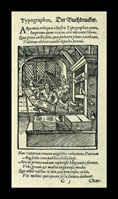Woodcut
 Historically this is the oldest
of the four techniques: it was invented in China in the ninth century, and woodblocks were
being used in Europe from the thirteenth century, although the first European prints on
paper can be traced only to the later fourteenth century.
Historically this is the oldest
of the four techniques: it was invented in China in the ninth century, and woodblocks were
being used in Europe from the thirteenth century, although the first European prints on
paper can be traced only to the later fourteenth century.
 The block itself was usually about an inch thick and of fairly soft
wood. The design would either be drawn on it, or on paper glued to the surface. The
woodcutter would then use a knife or a gouge to cut away the areas around the lines of the
design. Ink would then be applied to the remaining raised area using a dabber. The image
could then be transferred to paper in various ways: by stamping it onto paper by hand; by
rubbing the back of paper laid on top of the block; or, from the 1450s onwards, by use of a
press. Because the press worked on the same principle as that used for movable type, it was
possible to print together images with letterpress text, something which could not be done
in the intaglio processes. Despite this advantage, woodcuts fell into decline in the
seventeenth century relative to intaglio prints, primarily because finer images could be
created by the intaglio processes in which the craftsman directly created the black lines.
It is usually straightforward to distinguish a woodcut from one of the other techniques
included here. A woodcut will lack a platemark (the mark around the edges of intaglio
prints); lines are more likely to be uneven when compared to intaglio prints; and by looking
carefully it is usually easy to tell that lines will have been achieved by cutting around
them.
The block itself was usually about an inch thick and of fairly soft
wood. The design would either be drawn on it, or on paper glued to the surface. The
woodcutter would then use a knife or a gouge to cut away the areas around the lines of the
design. Ink would then be applied to the remaining raised area using a dabber. The image
could then be transferred to paper in various ways: by stamping it onto paper by hand; by
rubbing the back of paper laid on top of the block; or, from the 1450s onwards, by use of a
press. Because the press worked on the same principle as that used for movable type, it was
possible to print together images with letterpress text, something which could not be done
in the intaglio processes. Despite this advantage, woodcuts fell into decline in the
seventeenth century relative to intaglio prints, primarily because finer images could be
created by the intaglio processes in which the craftsman directly created the black lines.
It is usually straightforward to distinguish a woodcut from one of the other techniques
included here. A woodcut will lack a platemark (the mark around the edges of intaglio
prints); lines are more likely to be uneven when compared to intaglio prints; and by looking
carefully it is usually easy to tell that lines will have been achieved by cutting around
them.